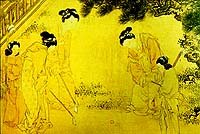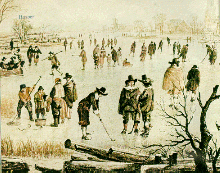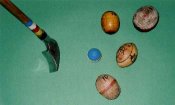|
|
|

The origins of hockey are difficult to trace. People have been hitting rocks with sticks since, well, there were people, rocks and sticks. Many of these stick-and-ball (or rock) games began to be organized as early as the 10th century. It is interesting to note that both hockey and golf have their roots in the same ancient sports. Most notably among these are:
|
|
 |
|
 |
|
 |
|
 |
|
So, basically, hockey as we know it has simply evolved through a variety of influences over the last 800 years or so. The development of ball hockey has closely followed that of ice hockey, and, due to this close relationship, both games developed with similar rules.
Organized Dek hockey- or ball hockey as it is known throughout the rest of the world- is a relatively young sport. The game evolved from the haphazard street hockey games that every guy over the age of 40 fondly remembers. Those games simply involved a few friends, an open area such as a street, parking lot, playground or tennis court, some rocks or bricks to mark the goal posts, a tennis ball, old hockey sticks, and the game was on.
Formally organized leagues grew independently in several countries. The Canadians were the first to organize the game in the late 1960s in Toronto, Ontario, with Habitant Arena hosting a summer program in 1969. There followed the USA in the early 1970s, Austria, The Czech Republic, and Slovakia in the 1980s, and Finland, Germany, Japan, and Switzerland in the early 1990s.
The oldest continuously run league is the Mississauga Ball Hockey Association, which commenced in 1971. The first governing body was the Canadian Ball Hockey Association which was founded in 1977 to standardize the game and hold competitions between the various leagues. After the political changes in Eastern Europe in 1989, international competitions were held beginning in 1991, leading to the establishment of the International Street & Ball Hockey Federation in 1993, and the bi-annual World Junior and Senior Championships, which commenced in 1996.
Ball hockey received its biggest boost in 1970, when Arnold Herka, of Viceroy Rubber (worlds largest producer of hockey pucks) developed the first plastic orange balls. He gave the balls to George Butterwick, who was operating a league in Toronto, and the game has never looked back.
The idea of Modular Sports Flooring- the technical term for the Dek- appears to have been around since the early 1960s. While the concept was sound, the materials used lacked durability. One of the most successful of the early pioneers was Dan Kotler, who started the development of a modular recreation court for backyard use in the mid 1960's. However, it wasn't until 1974 that advancements in the plastic industry enabled him to introduce the first Sport Court® Game Court. In 1977, Sports Illustrated and Newsweek did back to back articles on Sport Court, Inc. The articles raised the profile of Modular Sports Flooring, and ball hockey quickly made the move off of the pavement and onto the Dek.
© copyright 2002, Rich Rodriguez. All rights reserved.